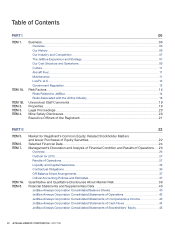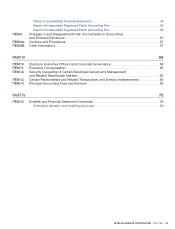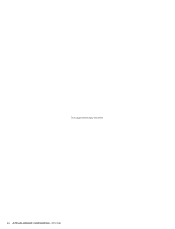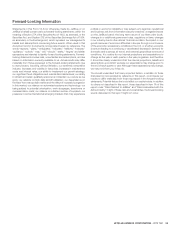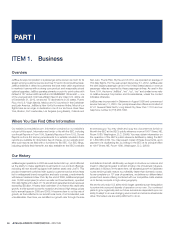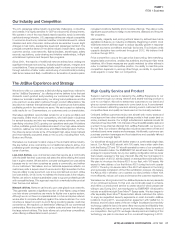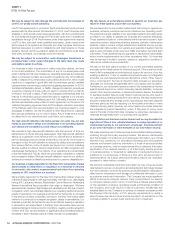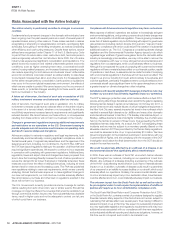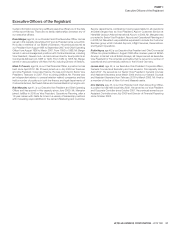JetBlue Airlines 2012 Annual Report Download - page 16
Download and view the complete annual report
Please find page 16 of the 2012 JetBlue Airlines annual report below. You can navigate through the pages in the report by either clicking on the pages listed below, or by using the keyword search tool below to find specific information within the annual report.
JETBLUE AIRWAYS CORPORATION-2012 10K12
PART I
ITEM 1Business
weekly checks, “A” checks, diagnostics and routine repairs. All other
maintenance activity is sub-contracted to qualifi ed maintenance, repair
and overhaul organizations.
Aircraft heavy maintenance checks consist of a series of more complex
tasks that take from one to four weeks to accomplish. The typical frequency
for these events is once every 15months. We send our aircraft to FAA-
approved Aeroman facilities in El Salvador, Pemco in Tampa, Florida, Timco
in Lake City, Florida and Embraer Aircraft Maintenance Services in Nashville,
Tennessee. This work is all performed with oversight by JetBlue personnel.
Component and power plant maintenance, repairs and overhauls on
equipment such as engines, auxiliary power units, landing gears, pumps and
avionic computers are performed by a number of different FAA-approved
repair stations. For example, maintenance of our V2500 series engines
which power our Airbus A320 aircraft is performed under a 15-year service
agreement with MTU Maintenance Hannover GmbH of Germany, or MTU.
MTU is also a manufacturer of many of these engines components. Many
of our maintenance service agreements are based on a fi xed cost per
fl ying hour, which can vary based upon the age and other operating factors
impacting the related component. Required maintenance not covered
by one of our agreements is performed on a time and materials basis.
LiveTV, LLC
LiveTV, LLC, a wholly-owned subsidiary of JetBlue, provides in-fl ight
entertainment, voice communication and data connectivity services
for commercial and general aviation aircraft. LiveTV’s assets include
certain tangible equipment and interests in systems installed on its
customers’ aircraft, system components and spare parts in inventory, an
air-to-ground spectrum license granted by the Federal Communications
Commission, a network of approximately 80 ground stations across the
continental U.S., and rights to certain patents and intellectual property.
LiveTV’s major competitors in the in-fl ight entertainment systems market
include Rockwell Collins, Thales Avionics and Panasonic Avionics. Only
Panasonic is currently providing in-seat live television. In the voice and
data communication services market, LiveTV’s primary competitors are
GoGo, Row 44, Panasonic, OnAir and Aeromobile.
LiveTV has agreements with six other domestic and international commercial
airlines for the sale and installation of certain hardware, programming and
maintenance of its live in-seat satellite television and certain other products
and services. LiveTV also has general aviation customers to which it
supplies voice and data communication services. LiveTV continues to
pursue additional customers and related product enhancements. In 2011,
JetBlue entered into an agreement with ViaSat Inc. for in-fl ight broadband
connectivity. LiveTV is partnering with ViaSat Inc. to develop this in-fl ight
broadband connectivity for JetBlue and will help us to introduce it on
our aircraft beginning in 2013. LiveTV is also working with ViaSat Inc. to
support in-fl ight connectivity for other airlines in the future.
Government Regulation
General. We are subject to regulation by the agencies of the federal
government, including, but not limited to, the DOT, the FAA, the
Transportation Security Administration, or TSA, and other governmental
agencies. The DOT primarily regulates economic issues affecting air
service such as certifi cation and fi tness, insurance, consumer protection
and competitive practices. The DOT has the authority to investigate and
institute proceedings to enforce its economic regulations and may assess
civil penalties, revoke operating authority and seek criminal sanctions. In
February2000, the DOT granted us a certifi cate of public convenience
and necessity authorizing us to engage in air transportation within the
United States, its territories and possessions.
The FAA primarily regulates fl ight operations and, in particular, matters
affecting air safety such as airworthiness requirements for aircraft, the
licensing of pilots, mechanics and dispatchers, and the certifi cation of
fl ight attendants. The FAA requires each airline to obtain an operating
certifi cate authorizing the airline to operate at specifi c airports using specifi ed
equipment. We have and maintain FAA certifi cates of airworthiness for
all of our aircraft and have the necessary FAA authority to fl y to all of the
cities we currently serve.
Like all U.S. certifi ed carriers, we cannot fl y to new destinations without
the prior authorization of the FAA. The FAA has the authority to modify,
suspend temporarily or revoke permanently our authority to provide air
transportation or that of our licensed personnel, after providing notice
and a hearing, for failure to comply with FAA regulations. The FAA can
assess civil penalties for such failures or institute proceedings for the
imposition and collection of monetary fi nes for the violation of certain FAA
regulations. The FAA can revoke our authority to provide air transportation
on an emergency basis, without providing notice and a hearing, where
signifi cant safety issues are involved. The FAA monitors our compliance
with maintenance, fl ight operations and safety regulations, maintains onsite
representatives and performs frequent spot inspections of our aircraft,
employees and records.
The FAA also has the authority to issue airworthiness directives and other
mandatory orders relating to, among other things, inspection of aircraft
and engines, fi re retardant and smoke detection devices, collision and
windshear avoidance systems, noise abatement and the mandatory removal
and replacement of aircraft parts that have failed or may fail in the future.
The TSA operates under the Department of Homeland Security and is
responsible for all civil aviation security, including passenger and baggage
screening, cargo security measures, airport security, assessment and
distribution of intelligence, and security research and development.
The TSA also has law enforcement powers and the authority to issue
regulations, including in cases of national emergency, without a notice
or comment period.
In December 2009, the DOT issued a rule, which among other things,
requires carriers not to permit domestic fl ights to remain on the tarmac
for more than three hours (the “Tarmac Delay regulations”). The rule
became effective in April 2010. Violators can be fi ned up to a maximum
of $27,500 per passenger. The new rule also introduced requirements to
disclose on-time performance and delay statistics for certain fl ights. This
new rule may have adverse consequences on our business and our results
of operations. In October 2011, several airport and navigational system
outages combined with a severe winter storm impacted the northeast
which resulted in numerous fl ight diversions, by us and other domestic and
international carriers, to Hartford, CT’s Bradley International Airport. Due to
weather, fi eld and airport terminal conditions, fi ve of our six diverted fl ights
were held on the tarmac for times which exceeded the DOT’s established
tarmac delay limits. As a result, the DOT is formally investigating these
incidents and we may be subject to a civil penalty.
As part of an additional set of consumer protection rules issued by the DOT,
as of January 2012, the DOT requires any advertised price for airfare or
a tour package including airfare (e.g., a hotel/air vacation package) to be
the total price to be paid by the customer, including all government taxes
and fees.The new policy applies to all U.S. and foreign air carriers and
ticket agents that advertise in the U.S. (including via the internet). Under the


